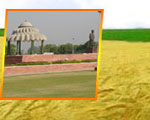| Encyclopedia of Tours and Travel to Haryana, featuring information on Fairs & Festivals, Wildlife, Excursion, Adventure & Weather of Haryana. |
 |
 |
 |
 |
 |
 |
 |
||
|
Jind
The district derives its name from its headquarters town Jind that is said to be a corruption of Jaintapuri. It is also said that this town had been founded at the time of Mahabharta. According to an old saying the Pandavas built a temple in honour of Jainti Devi (the goddess of victory), offered prayers for success, and then launched the battle with the Kauravas. The town grew up around the temple and was named Jaintapuri (Abode of Jainti Devi) which later on came to be known as Jind. Excursion The town, headquarter of the district of the same name is situated on the Ferozpur-Delhi section of the Northern Railway, 123 kilometers away from Delhi and 57 Kilometers from Rohtak. It is also connected by road with Delhi, Patiala, Chandigarh and other important towns of the state. Tradition assigns the settlement of the town to the Mahabharta period. According to the legend, the Pandavas built here a temple in honour of Jainti Devi(the goddess of victory) and offered prayers for success in their battle against the Kauravas. The town grew up around the temple and was named Jaintapuri) abode of Jainti Devi) which in course of time corrupted to Jind. Raja Gajpat Singh in 1755 seized a large tract of country including the present districts of Jind from the Afghan and made Jind the capital of the state in 1776. He made a fort here in 1775. Later, Sangrur was chosen as capital of Jind State by Raja Sangat Singh (1822 A.D to 1834 A.D) Jind is noted for its numerous temples sacred to the worship of Shiva. Raghbir Singh, ruler of Jind, built a temple known as Bhuteshvara temple, with a large tank around it, locally known as Rani Talab. It has been renovated and a tourist complex has been built nearby. The other places of worship are the temples of Hari Kailash , tanks of Surya Kund, Jawala Maleshvara tirath. There is a shrine of Shah Walayat where an annual urs is held. There is also a gurdwara in the sacred memory of Guru Teg Bahadur who on his way to Delhi stayed here for sometime. The town developed fast after the formation of Haryana and is a well provided town of the state. The town has a Arjun stadium, milk plant, cattle feed plant, Bulbul restaurant and a large grain market. There are facilities for the stay at PWD rest house, canal rest house and market committee rest house. The town is well provided with schools, colleges, hospitals and other basic amenities. Pindara (Tahsil Jind) According to a legend, the Pandavas offered here pinds to their
forefathers and hence the popular name of the village is P Ramrai (Tahsil Jind) Ramrai or Ramahrada is a traditional south-west Yaksha of the Kurukshetra region. It is connected with the mythological story of Parsurama who after the annihilation of Kshatriyas, filled five pools with their blood and propitiated his forefathers there. It is believed that a bath at Ramahrada tirtha and Sanet tirtha is very holy. There is an old temple of Parsuram where he is worshipped. Dhamtan Sahib (Tehsil Narwana) Dhamtan is the corrupted name of Dharamsthan (religious place). It is said to be the ashram of Rishi Valmiki and venue of Asvamedha yagya of Lord Rama. Guru Tegh Bahadur, the ninth Sikh guru stayed here on his way to Delhi and a fort like gurudwara was built in his memory. There is also another gurudwara know as Manji Sahib. Hansdehar (Tahsil Narwana) A Shiva temple and Bindusar tirtha is located here. The people worship Shiva and come in great number on Somavati Amavas to take holy bath in the tank. Narwana Narwana is said to be the corrupted name of the word Nirvan’ which means salvation. There is a tomb of Sufi Saint Hazrat Gaibi Sahib who is said to have miraculously disappeared in ground. There is a tank around the tomb. The town has PWD rest house, canal rest house, schools, colleges, hospitals, bus stand and other basic amenities. Safidon The place is possibly the site of Sarpadevi or Sarpidadhi referred in Mahabharta and Vamna Puran. It is associated with snake sacrifice of Janamejaya son of Parikshit. The latter lost his life in the struggle against the Nagas of Taxile, which was later avenged by his son Janamejaya, symbolised in the epic tradition of Sarpasastra (snake sacrifice) which possibly took place at Sarpadevi. There are three ancient temples and tirthas of Negesvara Mahadeva, Nagadamni Devi and Nagashetra. It has a rest house, schools, hospital and other basic amenities.
Uchana (Tahsil Narwana) There is a famous Dharmarth eyes hospital built by a Sanyasi Ganesh Nandh through public donation. The other places of public utility include a milk-chilling centre and a big grain market. There are many tirthas mentioned in the old texts, which are located in the district. A description of more important place along with the legends associated with them is given below: Asvini Kumara Tirtha Varaha Ekahamsa Yakshini Tirtha Pushkara Dasasvamedha tirtha Panchanada Koti tirtha Mention may also be made of Parasara tank and a brick temple of Mahadeva at Paju Kalan (5 Kilometers north-west of Safidon), Suraj Kund built in honour of Sun God at Kalwa (15 Kilometers south-west of Safidon), temple of Mahadeva at Barod (5.5 Kilometers north-east of Safidon) and a tank named after the Vedic sage Vasishtha at Budha Khera (12 Kilometers north-west of Safidon ).
|
||||||||||
|
||||||||||
|
||||||||||
|---|---|---|---|---|---|---|---|---|---|---|

